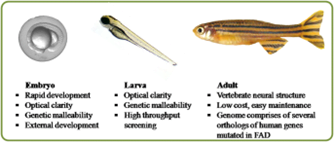Environment & Ecology
Context: According to a recent study by Agharkar Research Institute (ARI), Pune, a protein found in the backbone of zebrafish can have potential therapeutic implications.
About Zebrafish:

- The zebrafish is a freshwater fish belonging to the member of the minnow family of fish.
- It is a popular aquarium fish.
- Zebrafish typically inhabit moderately flowing to stagnant clear water of quite shallow depth in streams, canals, ditches, oxbow lakes, ponds and rice paddies.
- Native to South Asia where it is found in India, Pakistan, Bangladesh, Nepal and Bhutan.
- The zebrafish is an important and widely used vertebrate model organism in scientific research, for example in drug development, in particular pre-clinical development.
- It is also notable for its regenerative abilities and has been modified by researchers to produce many transgenic strains.
Significance of new study:
- A protein found in the backbone of zebrafish plays a positive role in disc maintenance and promotes regeneration in aged discs between vertebrae.
- This protein of zebrafish can have potential therapeutic implications to promote regeneration in degenerated human discs.
- In humans, discs degenerate naturally, leading to many related health concerns, including low back, neck, and appendage pain.
- Currently, only symptomatic treatments for disc degeneration are available, including pain relievers or anti-inflammatories.
- In severe cases, disc replacement or disc fusion surgery is performed.
- Transparent Embryo:
- Zebrafish are useful because the embryo is transparent, it develops outside of its mother, and its development from eggs to larvae happens in just three days.
- Faster development:
- The other main advantage is that they develop incredibly fast.
- So from a single cell the day they’re born, they will have a head, and a tail, and a beating heart within 24 hours.
- By 72 hours their brains are working, and fins and trunk are twitching, and by five days old they are swimming around and they’re hunting and they’re fully viable organisms.
- This is perfect essentially for both geneticists and developmental biologists.
Source: PIB
Previous Year Questions
Q.1) Which of the following is not a bird? (2022)
- Golden Mahseer
- Indian Nightjar
- Spoonbill
- White Ibis
Q.2) Certain species of which one of the following organisms are well known as cultivators of fungi? (2022)
- Ant
- Cockroach
- Crab
- Spider














